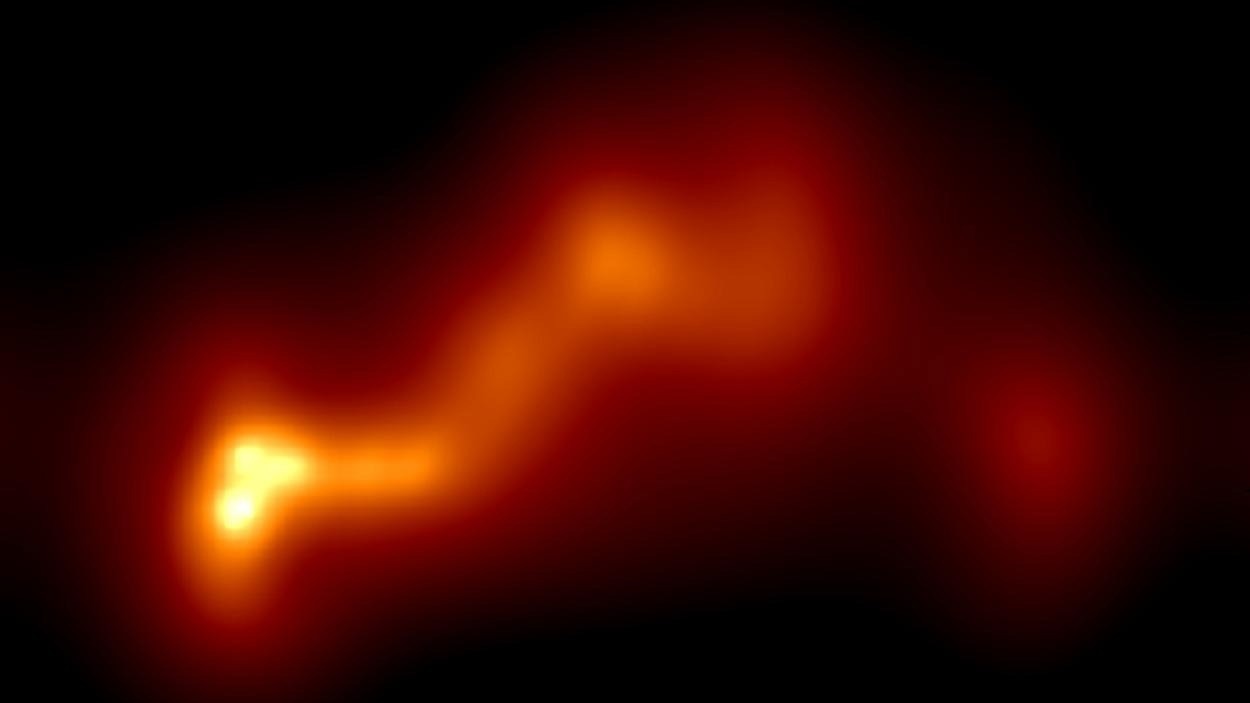Recently, an international research team headed by Heidelberg University’s Dr. Efthalia Traianou was able to capture a unique level of detail in a photograph of the galaxy’s core. The findings were published in the journal Astronomy and Astrophysics.
 A new image of galaxy OJ 287 reveals for the first time the sharply curved, ribbon-like structure of the plasma jet emitted from its center. Image Credit: Dr Efthalia Traianou, Heidelberg University, IWR
A new image of galaxy OJ 287 reveals for the first time the sharply curved, ribbon-like structure of the plasma jet emitted from its center. Image Credit: Dr Efthalia Traianou, Heidelberg University, IWR
Astronomers have been puzzled by the unusual brightness fluctuations of the OJ 287 galaxy, located five billion light-years away, for over 150 years. The leading theory is that these variations are caused by two supermassive black holes merging at the galaxy’s core.
Using a space radio telescope, the ground-breaking image reveals a previously unidentified, sharply curved section of the plasma jet whirling out from the galaxy’s core. The image offers fresh perspectives on the harsh circumstances that surround supermassive black holes.
The center of the OJ 287 galaxy is a blazar, which means it is very active and has a high brightness. Black holes are the driving factors that power these dynamic galactic centers. They draw in matter from their surroundings and can eject it as enormous plasma jets, streams of cosmic radiation, heat, heavy atoms, and magnetic fields.
We have never before observed a structure in the OJ 287 galaxy at the level of detail seen in the new image.
Dr. Efthalia Traianou, Postdoctoral Researcher, Interdisciplinary Center for Scientific Computing, Heidelberg University
The image, which reaches deep into the galaxy’s center, exposes the jet’s strongly curved, ribbon-like shape, as well as new information about the plasma jet's composition and activity. Some places have temperatures that reach 10 trillion degrees Kelvin, indicating the discharge of enormous energy and movement near a black hole.
The researchers also saw the production, spread, and collision of a new shock wave along the jet, which they ascribe to energy in the trillion-electron-volt range, derived from an unusual gamma ray observation made in 2017.
The radio image was captured using a ground-space radio interferometer that included a radio telescope in Earth's orbit (a ten-meter-long antenna from the RadioAstron mission on board the Spektr-R satellite) as well as a network of 27 ground observatories spread around the planet.
The researchers effectively created a virtual space telescope with a diameter five times that of Earth. Its remarkable resolution comes from the vast distances between the individual radio observatories involved. The image is created using a measurement technique that leverages the wave nature of light and the interference patterns produced by overlapping waves.
The interferometric image supports the hypothesis that a twin supermassive black hole exists within galaxy OJ 287. It also reveals critical information about how the motions of such black holes affect the shape and orientation of the plasma jets released.
“Its special properties make the galaxy an ideal candidate for further research into merging black holes and the associated gravitational waves,” stated Efthalia Traianou.
Institutions from Germany, Italy, Russia, Spain, South Korea, and the United States all contributed to the study. It received backing from a variety of research and funding institutions.
Journal Reference:
Traianou, E., et al. (2025) Revealing a ribbon-like jet in OJ 287 with RadioAstron. Astronomy and Astrophysics. doi.org/10.1051/0004-6361/202554929.